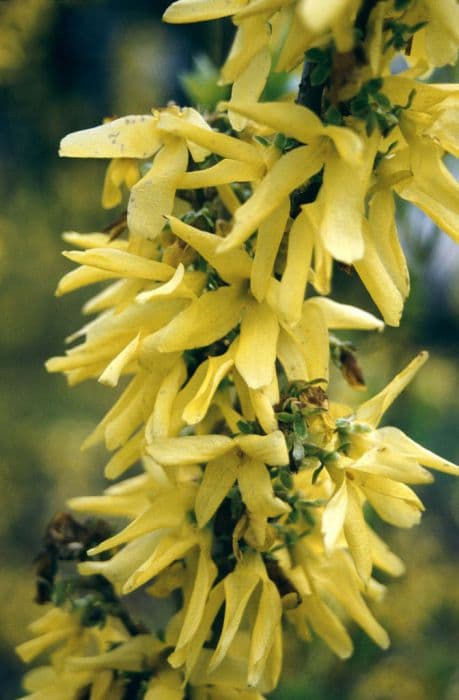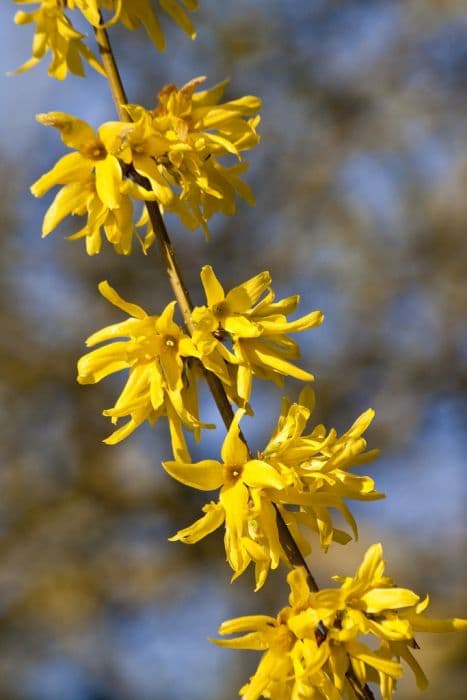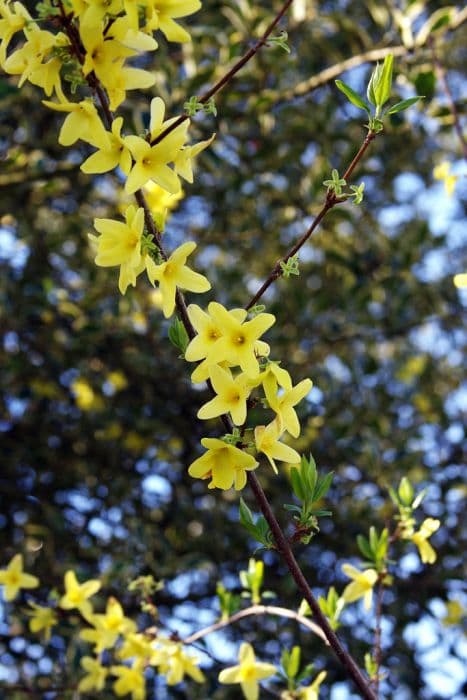White Forsythia Abeliophyllum distichum

ABOUT
The plant commonly known as white forsythia is a deciduous shrub with a graceful, spreading shape. Its branches are covered with oval-shaped, opposite leaves that have a soft texture and a green color that turns to shades of purple or yellow before falling in autumn. The most distinctive feature of the white forsythia is its early spring flowers. Prior to the appearance of its leaves, the plant is adorned with an abundance of fragrant, four-petaled flowers that are white or faintly pink. These blooms are clustered along the stems, creating a striking contrast against the bare branches. The appearance of these blooms is one of the first signs of spring in the landscape. The plant's bark is tan or gray, providing visual interest even after the leaves have fallen. Overall, white forsythia has a delicate and airy presence in the garden, with its bloom time and foliage transition contributing to its ornamental value throughout the seasons.
About this plant
 Names
NamesFamily
Oleaceae
Synonyms
White Forsythia, Korean Abelialeaf
Common names
Abeliophyllum distichum
 Toxicity
ToxicityTo humans
White forsythia (Abeliophyllum distichum) is not commonly known to be toxic to humans. There are no well-documented cases or reports of poisoning from ingesting any part of this plant. However, as with any plant material, individual allergies or sensitivities can occur, so it is generally advised not to consume parts of ornamental plants not meant for human consumption.
To pets
White forsythia (Abeliophyllum distichum) is not commonly known to be toxic to pets. There are no specific reports of toxicity in domestic animals such as dogs and cats from ingesting parts of this plant. Despite this, it is always prudent to prevent pets from eating ornamental plants, as individual animals might have different sensitivities or reactions.
 Characteristics
CharacteristicsLife cycle
Perennials
Foliage type
Deciduous
Color of leaves
Green
Flower color
White
Height
4-5 feet (1.2-1.5 meters)
Spread
4-6 feet (1.2-1.8 meters)
Plant type
Shrub
Hardiness zones
5
Native area
Korea
Benefits
 General Benefits
General Benefits- Ornamental Value: White Forsythia is valued for its early spring blossoms that provide a decorative display with fragrant, white to pink flowers.
- Low Maintenance: This plant is known for being easy to care for, requiring minimal pruning and upkeep once established.
- Drought Tolerance: White Forsythia can withstand periods of dryness once fully established, making it suitable for xeriscaping or low-water gardens.
- Wildlife Attraction: The flowers of the White Forsythia can attract pollinators such as bees, which are essential for the ecosystem.
- Seasonal Interest: It adds interest to winter and early spring landscapes, often flowering before other plants and signaling the coming of spring.
- Compact Growth: With its modest size, it is well-suited for small gardens, urban spaces, or as part of foundation plantings.
- Breeding Potential: Horticulturists may use White Forsythia in breeding programs to develop new garden cultivars with desirable characteristics.
 Medical Properties
Medical PropertiesThis plant is not used for medical purposes.
 Air-purifying Qualities
Air-purifying QualitiesThis plant is not specifically known for air purifying qualities.
 Other Uses
Other Uses- White forsythia branches can be used for ornamental winter displays, as the bare branches with their unique structure provide visual interest during the colder months.
- The plant's ability to flower in winter can provide an essential food source for early foraging bees when other nectar sources are scarce.
- White forsythia's dense foliage makes it suitable for planting as a privacy screen or hedge in residential landscapes.
- Dried white forsythia flowers are sometimes used in potpourri mixtures, providing a natural fragrance and decorative appearance.
- The plant is often utilized in bonsai culture, where its early bloom and graceful branches are highly valued for the art form.
- Landscape artists may use white forsythia in ecological artworks or garden installations due to its distinct blooming characteristic.
- White forsythia can be planted to combat soil erosion on slopes due to its root system that can help stabilize the soil.
- The plant may be used in educational settings, such as biology classes, to study plant phenology and flowering responses to climatic conditions.
- White forsythia can be included in wildlife gardens to provide shelter and potential nesting sites for birds due to its dense growth.
- In photography, the early blooming flowers of white forsythia are often sought after for spring-themed photoshoots.
Interesting Facts
 Feng Shui
Feng ShuiThe White Forsythia is not used in Feng Shui practice.
 Zodiac Sign Compitability
Zodiac Sign CompitabilityThe White Forsythia is not used in astrology practice.
 Plant Symbolism
Plant Symbolism- Transience of life: Abeliophyllum distichum, commonly known as the White Forsythia, blooms early in spring with delicate white flowers that wilt quickly, symbolizing the ephemeral nature of existence.
- Purity: The pure white flowers of the White Forsythia represent innocence and purity, often connected with the start of new beginnings.
- Anticipation and hope: The early blooming of this plant indicates the end of winter and the start of spring, symbolizing hope and the anticipation of better times to come.
- Renewal and rejuvenation: Similar to other early spring bloomers, the White Forsythia symbolizes renewal and the rejuvenation of nature after the cold, dormant winter period.
 Water
WaterThe White Forsythia should be watered deeply, ensuring moisture reaches the roots. Typically, it needs water once every week, but during periods of drought or excessive heat, it may require watering twice a week. The amount necessary is typically about 1.5 gallons for an established plant in moderate climates; adjust accordingly based on rainfall, temperature, and the plant's age. Overwatering should be avoided to prevent root rot, always check the soil moisture before watering.
 Light
LightWhite Forsythia thrives in full sun to partial shade. The ideal location is a spot where it can receive at least 4-6 hours of sunlight daily, but it can also tolerate some light afternoon shade. Avoid deep shade since it will limit blooming and can lead to an unhealthy plant.
 Temperature
TemperatureWhite Forsythia prefers temperate climates and can survive in temperatures as low as 5 degrees Fahrenheit, and as high as 90 degrees Fahrenheit, although it thrives best when the temperature ranges from 60 to 75 degrees Fahrenheit. Protection from extreme cold and frost is important to prevent damage to the plant.
 Pruning
PruningPruning White Forsythia is essential to maintain its shape and encourage vibrant blooms. Prune immediately after flowering since the plant blooms on the previous year's growth. Thin out old and overcrowded branches, cutting them back to the ground to rejuvenate the plant. Annually pruning about a third of the oldest stems is often recommended.
 Cleaning
CleaningAs needed
 Soil
SoilWhite Forsythia thrives in well-draining loamy soil with a pH range of 5.5 to 7.0. A mix containing garden soil, compost, and sand or perlite is ideal to provide the necessary nutrients and drainage. Regular application of a balanced fertilizer during the growing season will enhance growth and blooming.
 Repotting
RepottingWhite Forsythia does not require frequent repotting and can be done every 2-3 years. It's best to repot in late winter or early spring before new growth begins, using a slightly larger pot to accommodate root growth.
 Humidity & Misting
Humidity & MistingWhite Forsythia prefers moderate humidity levels however, it's adaptable and doesn't require specific humidity conditions. It grows well in typical outdoor humidity ranges.
 Suitable locations
Suitable locationsIndoor
Place White Forsythia in bright, indirect light indoors.
Outdoor
Choose a sunny to part-shade spot with moist soil.
Hardiness zone
5-7 USDA
 Life cycle
Life cycleWhite forsythia, or Abeliophyllum distichum, begins its life as a seed, which germinates in favorable conditions of moisture and temperature, typically in late spring or early summer. The seedling emerges and develops into a young plant, going through a vegetative stage where it produces leaves and stems, photosynthesizing to fuel its growth. As it matures, it enters a flowering stage, typically in early spring before the leaves fully develop, where it displays white or slightly pinkish fragrant flowers. Following pollination, often by insects, the plant produces fruits that contain seeds, completing the reproductive cycle. After fruiting, the plant enters a period of dormancy during the winter months, conserving energy. The white forsythia continues this cycle annually, with the plant gradually increasing in size and spread until it reaches maturity, after which it can live for several decades if conditions are suitable.
 Propogation
PropogationPropogation time
Early spring
The most popular method of propagation for Abeliophyllum distichum, commonly known as White Forsythia, is through softwood cuttings. This process is usually carried out in late spring or early summer when the plant is actively growing. Cuttings of about 4 to 6 inches (10 to 15 centimeters) long are taken from healthy, current year's growth. The lower leaves are removed, and the cut end is often dipped in rooting hormone to enhance root development. Then, the cutting is inserted into a pot filled with a well-draining potting mix or a mixture of peat and perlite. The pot is kept under conditions of high humidity, often in a propagator or by covering it with a plastic bag to maintain moisture. In a few weeks, the cuttings should root and can be transplanted into individual pots to grow on before being planted out.







